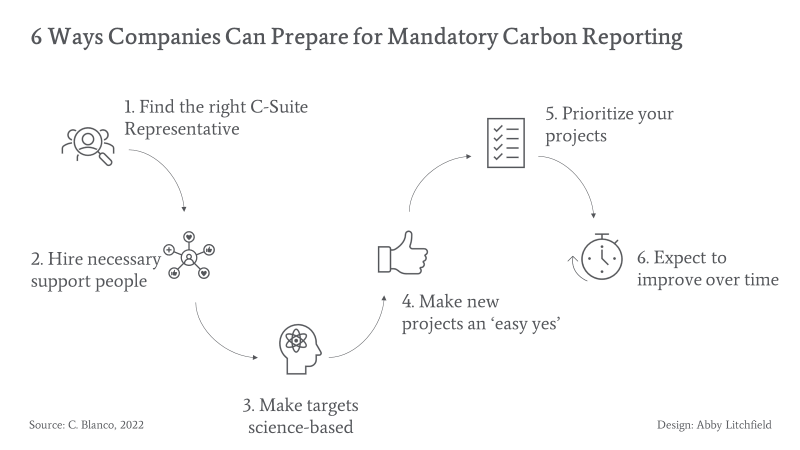Carbon reporting is becoming mandatory for many companies. Find out how your company can get ready to disclose its carbon emissions and policies.
As the Earth warms and humans experience the negative impacts of climate change, investors and society are pressuring companies to react. They want companies to be transparent about – and accountable for – their greenhouse gas emissions.
This pressure has led to a host of standards dictating how companies should report on their carbon performance. To date, the choice of whether to report and which standard to use was left to the company.
The shift to mandatory, standardized reporting
Now, the world of carbon reporting is moving towards greater standardization and mandatory reporting.
For example, a hotly-anticipated rule from the US Securities and Exchange Commission (SEC) will soon require all publicly-traded companies in the US to disclose:
- How they identify and respond to climate-related risks and opportunities.
- The financial and strategic implications of risks and opportunities, both now and in the future.
- Their total carbon or greenhouse gas emissions. Larger companies will also need to account for emissions produced by suppliers and customers (“Scope 3 emissions”).
Mandatory requirements are also emerging in the European Union and other regions.
What does this mean for your company?
In this article, Dr. Christian Blanco of Ohio State University explains how companies can effectively meet reporting requirements. He draws on his decade of research on voluntary carbon reporting.
His advice refers specifically to the new rules proposed by the US Securities and Exchange Commission but relates to mandatory reporting in any region.
6 ways companies can prepare for mandatory carbon reporting
Companies that have already been reporting their carbon performance voluntarily will have an easy adjustment to the new SEC rules, says Blanco. That’s because those rules draw heavily on existing voluntary frameworks (e.g. CDP, Task Force on Climate-Related Financial Disclosures, and the Greenhouse Gas Protocol).
For companies who are new to carbon reporting, here are six key steps to getting started.
1. Find the right C-suite representative.
Companies will need to disclose who oversees their climate change strategy. Someone senior should be in that role, so they can act on the risks and opportunities uncovered in the disclosure process.
That person might be someone in the existing C-suite: the Chief Financial Officer or Chief Operating Officer. Alternatively, companies can look at hiring their first Chief Sustainability Officer.
2. Hire necessary support people.
For companies that have never reported on their carbon performance, there will be some major knowledge gaps to fill.
One strong approach is a carbon “tag team.” Bring on both:
- A consultant with experience in the voluntary reporting sector. This person can help create your company’s carbon reporting strategy.
- A junior staff person who can work alongside the consultant and soak up the knowledge required to execute reporting in-house in the future. The junior staff person can also facilitate communication with the C-suite rep.
3. Make targets science-based.
“When companies set targets, they may arbitrarily say, ‘We commit to reduce our emissions by 5%,” observes Blanco. “They don’t always consider the magnitude of emissions reduction we need in order to avoid the most harmful impacts of climate change.”
The truth is, slow and steady won’t be enough. The Earth has a measurable boundary we must stay within – 1.5 degrees Celsius of warming or less – to avoid the most harmful impacts of climate change. To achieve that goal, we need to cut emissions by 45-50% by 2030. That’s a huge amount.
Companies should keep that reality in mind and work backwards to create short-term goals. Then, check in against those goals quarterly.
(For more help setting evidence-based goals, consider working with The Science Based Targets Initiative.)
4. Make new projects an ‘easy yes’
Middle managers often find it tough to get funding for carbon reduction projects. While these projects are often profitable, their rate of return isn’t typically as high as traditional projects.
There are two ways your company can get around this barrier:
- Set an internal price of carbon, which is a fee your company charges itself for carbon emissions. This fee typically ranges from $5-20/metric ton. The fee improves the rate of return on emissions reduction projects, and money collected goes back to finance carbon reduction efforts.
- Or, create a separate project category for carbon reduction efforts, with an independent budget. Then the rate of return isn’t compared to traditional investments.
5. Prioritize your projects.
Once your company starts identifying risks and opportunities, you will want to take on new projects to address them. What’s the best way to prioritize?
Blanco studied 16,525 carbon reduction projects that companies reported through voluntary reporting from 2011-2016. He found that projects fell into six categories, each with different investment requirements and rates of return.
Here are his recommendations for prioritizing projects.
Seeking projects with a short payback period? Focus on transportation. Examples include shifting from road to rail and replacing gasoline fleet cars with electric (if grid electricity comes from renewable sources). Transportation projects have the shortest average payback period of roughly 2 years.
Seeking deep savings in the long-term? Blanco recommends renewable energy projects. Examples include installing in-house solar generation or purchasing renewable energy. Renewable energy projects have the highest upfront cost and longest payback period (4 years), but also the highest annual savings.
Have a low upfront budget? Look at behavioral interventions: for example, training employees to conserve energy and creating campaigns to promote energy efficiency practices. Changing employee behaviour doesn’t cost much, pays back quickly, and can still reduce emissions as much as transportation projects.
Blanco also studied projects related to materials (e.g. changing packaging, recovering materials; reusing, recycling and upcycling), industrial processes (e.g. more energy efficient pumps and motors), and buildings (e.g. energy efficient lighting; building certification standards). See his paper for more detail on their value.
6. Expect effective carbon reporting to develop over time.
It takes an average company 3-9 years to get their carbon reporting right, according to Blanco’s research. Reporting on suppliers’ emissions (Scope 3) is particularly tough. A large company might need to work with hundreds of suppliers on their reporting processes.
Companies should dive in and do their best, but also recognize the challenging learning curve, says Blanco. (The SEC rules do involve a phased in approach.)
How to meet shareholder expectations
Even if you do all 6 steps above – and even if you’ve reported your emissions voluntarily in the past – you may still find mandatory carbon reporting tough.
“In voluntary carbon reporting, your basically ‘preaching to the choir,’ explains Blanco. “The investors who look at your reports are those who already value environmental sustainability. But as the world shifts to mandatory reporting, companies will be reporting to all investors and will experience increased pressure to manage the optics of their reports.”
Blanco describes different pressure points that companies might encounter and how to handle each.
| Challenge | Solution |
|---|---|
| Mainstream investors may be wary of investments that lower carbon emissions but have a hefty up-front price tag. | Reassure them, in good faith. Many low-carbon technologies and processes are actually profitable. Emphasize the business case and note indirect benefits as well. For example, these initiatives could reduce costs, limit exposure to carbon taxes, and improve productivity. |
| Companies may be incentivized to hide undesirable outcomes. In SEC-mandated financial disclosures, companies use “accounting tricks” to make their statements look stronger. There’s evidence of inaccuracies in voluntary carbon reporting programs, too. | Yes, releasing information about carbon emissions can be scary for companies. Carbon reporting has been shown to lower share price because shareholders fear the cost of lowering emissions. But, given that reporting becoming mandatory, being consistent and transparent results in less market penalty. And deceptive reporting can lead to short-term gain but long-term pain. Just ask Volkswagen. |
| Companies may be concerned about being held accountable for failing to meet a target and plan. Therefore, they may choose not to set a target at all, or to opt for easy but less effective plans, like carbon offset purchases. | “Don’t shy away from setting a target,” encourages Blanco. “Just be sure to build flexibility into your plans.” Large scale infrastructure and process changes are never linear and often don’t go as initially planned. Aim for meaningful long-term changes like energy efficiency, circularity or nature-based solutions, while knowing that carbon offsets can be used to help achieve your goals if needed. |
Reporting means more data and more impact
Soon there will be a flood of climate change-related data from companies that have not reported in the past. That’s exciting, says Blanco. “This greater transparency will help companies, investors and other stakeholders make better, data-driven decisions. There are many challenges ahead, but let’s celebrate the small victories and dive into improving the system as we go.”






Add a Comment
This site uses User Verification plugin to reduce spam. See how your comment data is processed.This site uses User Verification plugin to reduce spam. See how your comment data is processed.